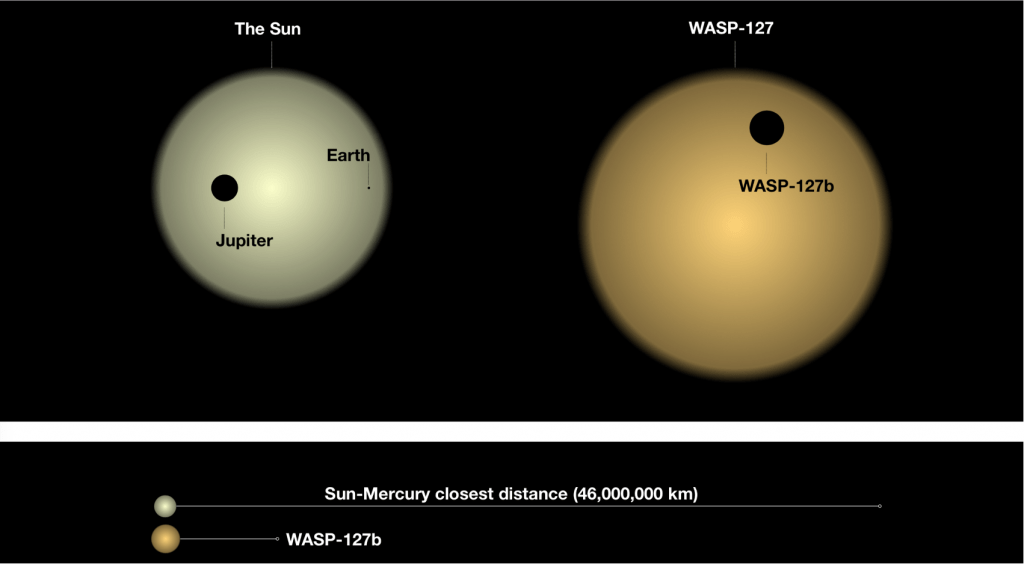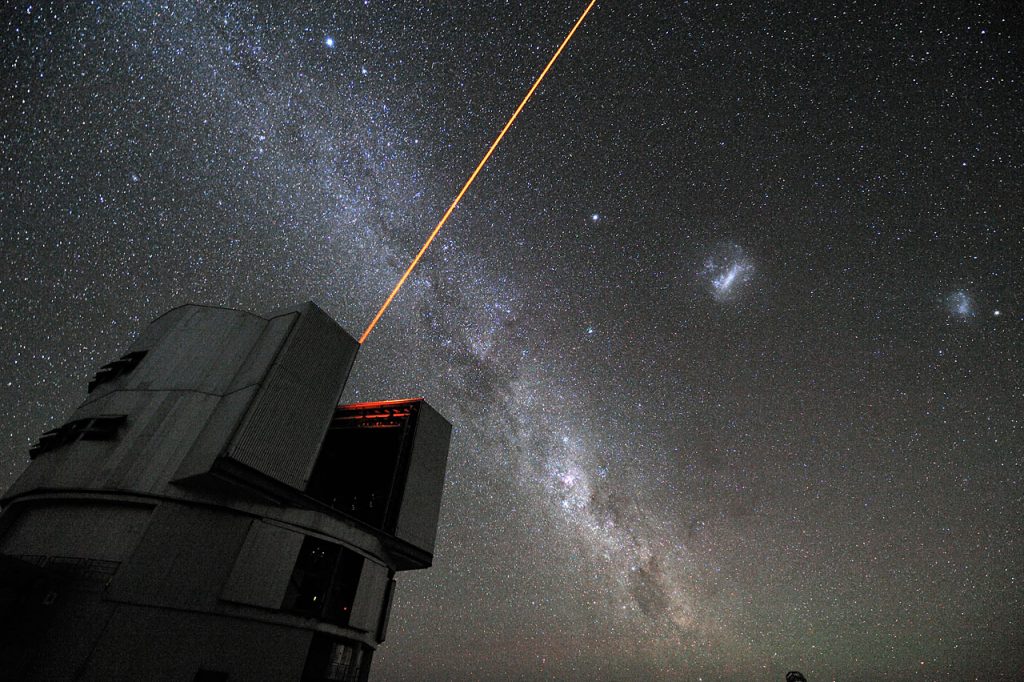The search for planets beyond our Solar System has grown immensely during the past few decades. To date, 4,521 extrasolar planets have been confirmed in 3,353 systems, with an additional 7,761 candidates awaiting confirmation. With so many distant worlds available for study (and improved instruments and methods), the process of exoplanet studies has been slowly transitioning away from discovery towards characterization.
For example, a team of international scientists recently showed how combining data from multiple observatories allowed them to reveal the structure and composition of an exoplanet’s upper atmosphere. The exoplanet in question is WASP-127b, a “hot Saturn” that orbits a Sun-like star located about 525 light-years away. These findings preview how astronomers will characterize exoplanet atmospheres and determine if they are conducive to life as we know it.
The research paper that describes their findings appeared in the December 2020 issue of Astronomy and Astrophysics. It was also the subject of a presentation made during the recent Europlanet Science Congress (EPSC) 2021, a virtual conference from September 13th to 24th, 2021. During the presentation, lead author Dr. Romain Allart showed how combining data from space-based, and ground-based telescopes detected clouds in WASP-127b’s upper atmosphere and measured their altitudes with unprecedented precision.
 Some of the elements making WASP-127b unique, compared with the planets of our Solar System. Credits: David Ehrenreich/Université de Genève, Romain Allart/Université de Montréal.
Some of the elements making WASP-127b unique, compared with the planets of our Solar System. Credits: David Ehrenreich/Université de Genève, Romain Allart/Université de Montréal.
Like many exoplanets discovered to date, WASP-127b is a gas giant that orbits very close to its parent star and has a very short orbital period – taking less than four days to complete a single orbit. The planet is also 10 billion years old, which is over twice as long as Earth (or “our” Saturn) has been around. Because of its close orbit, WASP-127b receives 600 times more irradiation than Earth and experiences atmospheric temperatures of up to 1,100°C (2012°F).
As a result, the planet’s atmosphere has expanded (or puffed up) to the point that it is 1.3 times as large as Jupiter but far less dense. In fact, WASP-127b is one of the least dense (or “fluffiest”) exoplanets discovered to date. This makes WASP-127b an ideal candidate for researchers working on atmospheric characterization, as the extended nature of fluffy exoplanets makes them easier to observe.
Using data obtained by the ESA/NASA Hubble Space Telescope (HST) and visible light measurements from the Very Large Telescope (VLT) at the ESO’s Paranal Observatory in Chile, the team observed WASP-127b as it made two passes in front of its star. Consistent with the Transit Method (aka. Transit Photometry), the team monitored WASP-127 for periodic dips in luminosity that indicated an exoplanet passing in front of the star (transiting) relative to the observation team.
Whereas Hubble obtained optical data that confirmed the transits, the VLT’s Echelle SPectrograph for Rocky Exoplanets and Stable Spectroscopic Observation (ESPRESSO) instrument obtained spectra from the light passing through WASP-127b’s upper atmosphere. Dr. Allart, a Trottier Postdoctoral Researcher at the Institute for Research on Exoplanets (iREX) at the Université de Montréal, led the study.
 The Very Large Telescope in Chile firing a laser from its adaptive optics system. Credit: ESO
The Very Large Telescope in Chile firing a laser from its adaptive optics system. Credit: ESO
The combined data allowed the researchers to trace the altitude of the clouds to an atmospheric layer moving at speeds of about 13.5 to 17 km/s (48,600 km/h; 61,200 mph). They further estimated that the cloud deck altitude conformed to an atmospheric pressure range of between 0.3 and 0.5 millibars. Lastly, they detected signs of tenuous atomic sodium in the atmosphere, though there were no indications of other atomic species or water. As he explained in a recent Europlanet Society statement:
“First, as found before in this type of planet, we detected the presence of sodium, but at a much lower altitude than we were expecting. Second, there were strong water vapor signals in the infrared but none at all at visible wavelengths. This implies that water vapor at lower levels is being screened by clouds that are opaque at visible wavelengths but transparent in the infrared.
“We don’t yet know the composition of the clouds, except that they are not composed of water droplets like on Earth. We are also puzzled about why the sodium is found in an unexpected place on this planet. Future studies will help us understand not only more about the atmospheric structure but about WASP-127b, which is proving to be a fascinating place.”
The team’s ESPRESSO observations also showed that WASP-127b has a retrograde orbit, meaning that it orbits in the opposite direction of its star’s rotation and that it orbits on a different plane than the star’s equatorial. “Such alignment is unexpected for a hot Saturn in an old stellar system and might be caused by an unknown companion,” said Allart. “All these unique characteristics make WASP-127b a planet that will be very intensely studied in the future.”
 TOI 1338 b is a circumbinary planet orbiting its two stars. It was discovered by TESS. Credit: NASA’s Goddard Space Flight Center/Chris Smith
TOI 1338 b is a circumbinary planet orbiting its two stars. It was discovered by TESS. Credit: NASA’s Goddard Space Flight Center/Chris Smith
These include space-based observatories like the James Webb Space Telescope (JWST) and the Nancy Grace Roman State Telescope (RST). Then there are ground-based observatories like the ESO’s Extremely Large Telescope (ELT), the Giant Magellan Telescope (GMT), and the Thirty Meter Telescope (TMT). With their combination of advanced imaging, coronagraphs, and/or adaptive optics, these facilities will allow astronomers to conduct detailed studies of exoplanet atmospheres.
Just as important is the fact that these studies will include rocky planets that orbit with the habitable zones (HZs) of their stars, not just gas giants with very distant or very close orbits (as was the case here). Since these “Earth-like” candidates are expected to be the most likely candidates for habitability, astrobiologists anticipate that it won’t be long before they find evidence of extraterrestrial life!
While the results of these studies are somewhat limited, the implications of the team’s research are anything but. In addition to demonstrating the effectiveness of combining data from multiple observatories, it also illustrates how astronomers are getting closer to the point where they can fully characterize an exoplanet’s atmosphere. With the introduction of next-generation observatories in the near future, these capabilities will become far greater.
Further Reading: Europlanet, Astronomy & Astrophysics

